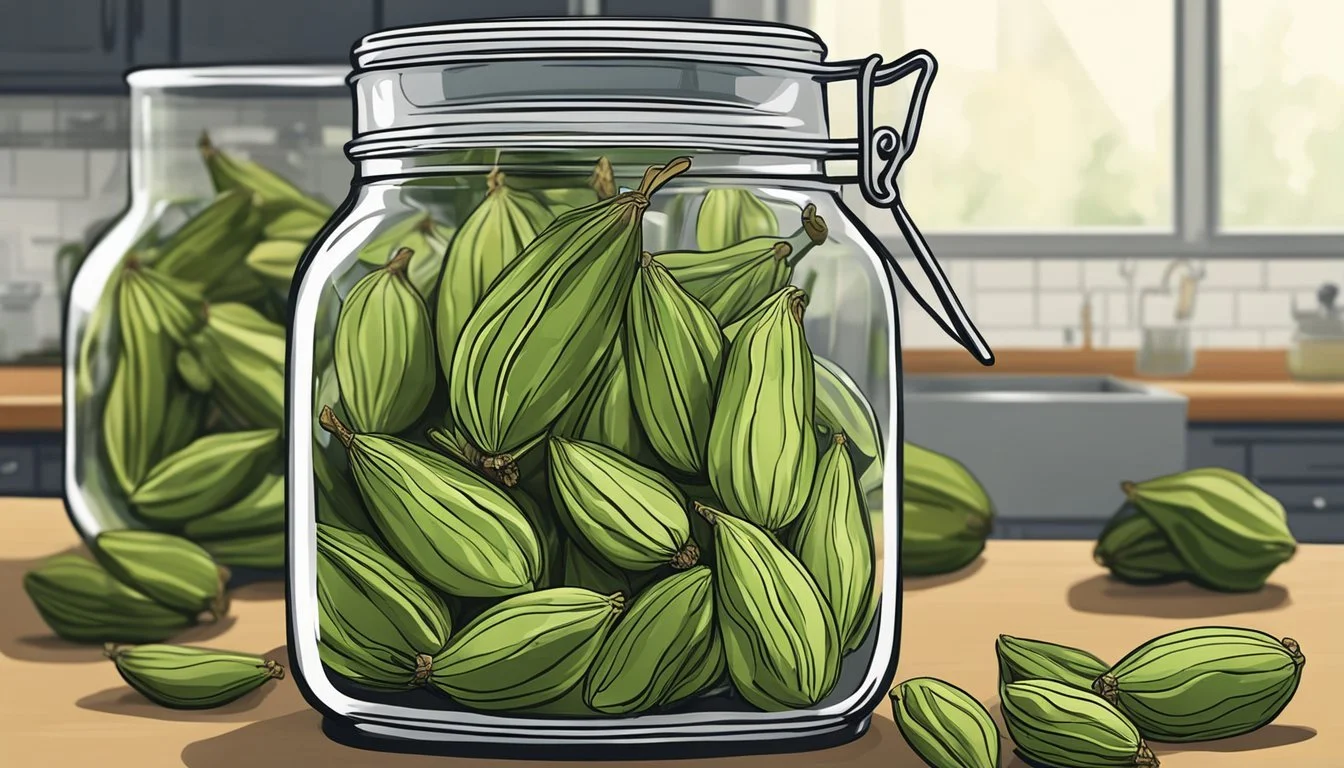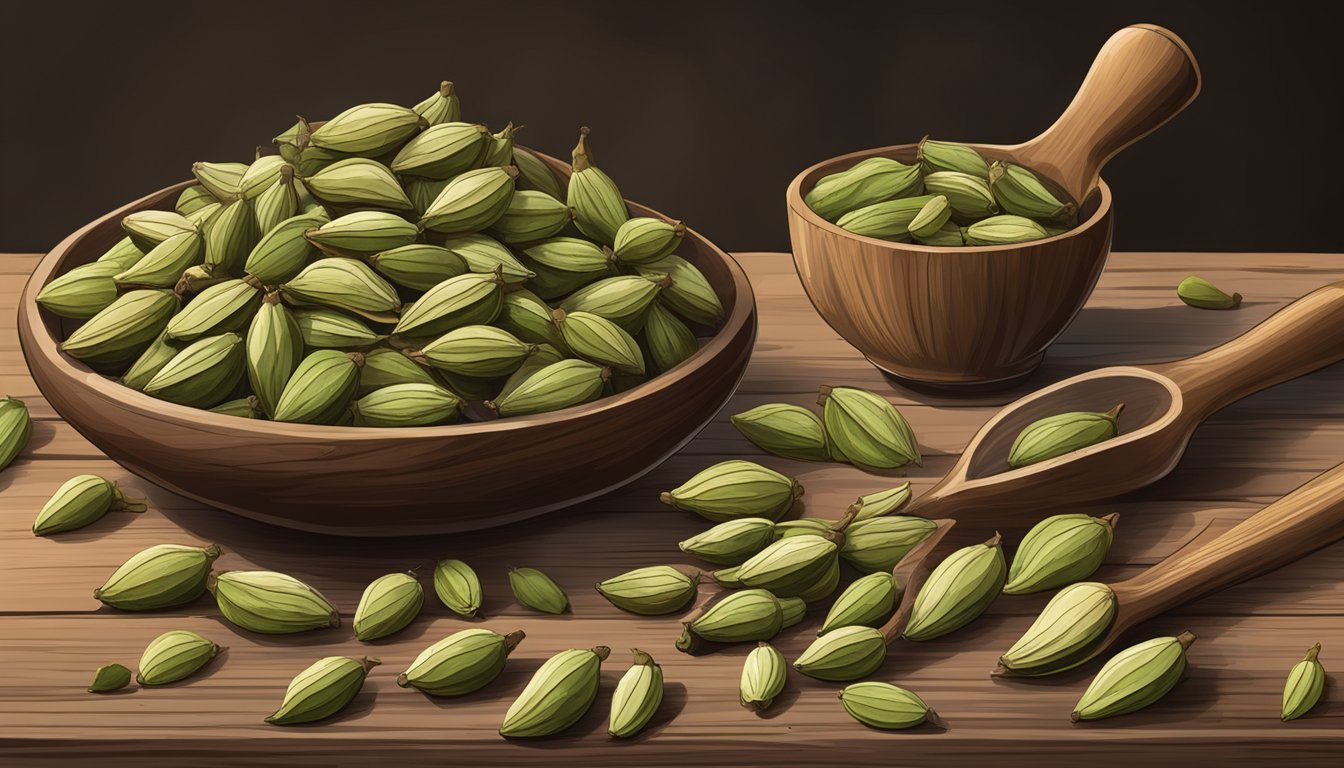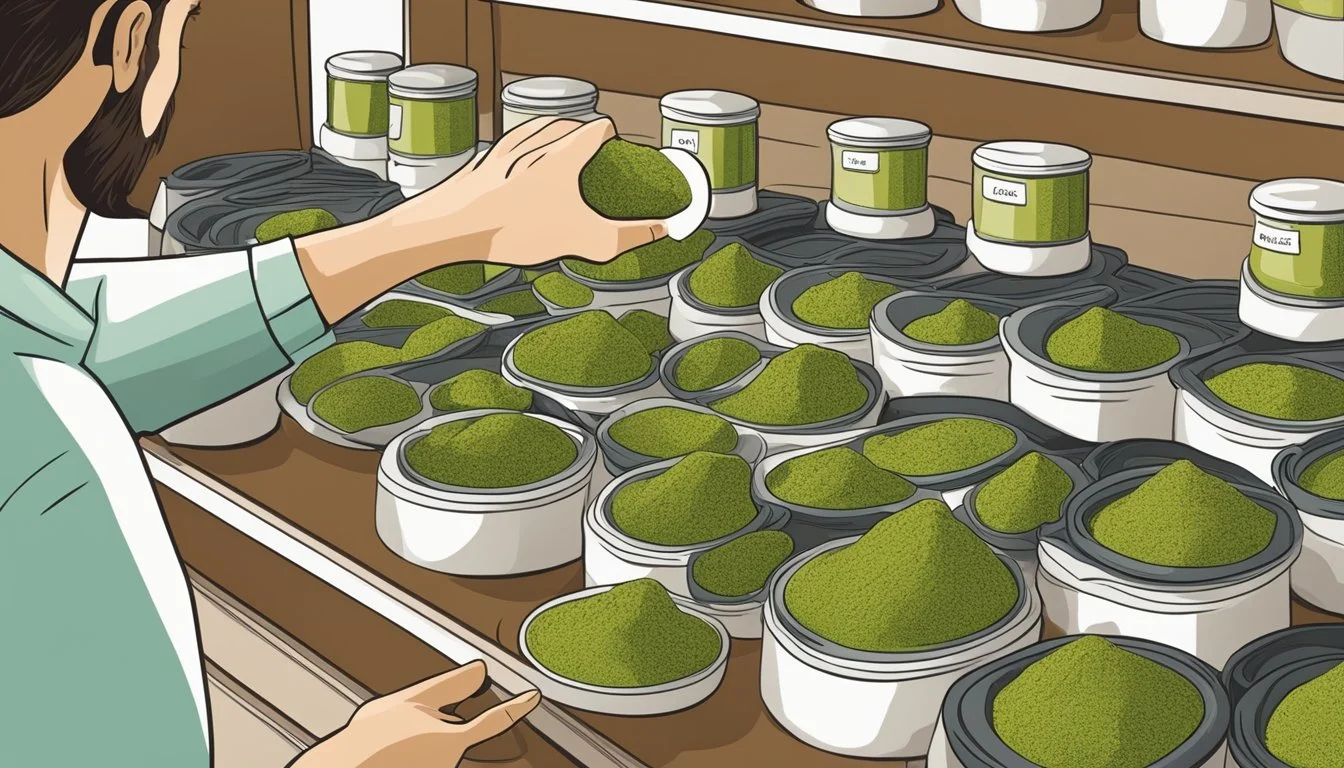How Long Do Cardamom Pods Last?
Shelf Life and Storage Tips
Cardamom pods are a prized spice, known for their intense flavor and aromatic qualities that can elevate the complexity of culinary dishes. Their shelf life is a point of interest for both culinary professionals and home cooks, given that the freshness of spices significantly impacts the taste of food. When stored properly in an airtight container away from light, heat, and moisture, cardamom pods can retain their potency for several years.
The longevity of cardamom pods over ground cardamom owes to the protective nature of the pod itself, which shields the seeds (how long do seeds last?) from environmental factors that hasten spoilage. While the shelf life of cardamom, when stored optimally, may extend up to three years or more, it's vital to note that their peak flavor diminishes gradually, making it ideal to use them closer to the purchase date. Even as they age, they don't spoil in a way that makes them unsafe for consumption, but rather they lose the intensity of their flavor and aroma over time.
Understanding Cardamom Pods
Cardamom, a spice native to the Indian subcontinent and Indonesia, is renowned for its unique flavor and aroma. This section delves into the different varieties available and the characteristics that signify fresh cardamom.
Varieties of Cardamom
The two primary types of cardamom are Green Cardamom (Elettaria cardamomum) and Black Cardamom (Amomum subulatum). Green cardamom, also known as true cardamom, is part of the Zingiberaceae family and is recognized by its small, green pods. It's a highly prized spice, often referred to as the "queen of spices," due to its intense aromatic profile. Conversely, black cardamom is larger, with a smokier flavor, and is typically used in savory dishes.
Furthermore, White Cardamom is essentially the bleached version of green cardamom. It has a milder flavor and is mostly used for aesthetic purposes in lighter-colored dishes.
Characteristics of Fresh Cardamom
Fresh cardamom pods exhibit a vibrant color specific to their variety—green cardamom with a bright green hue and black cardamom with a dark, rustic look. When assessing freshness, one should look for the following characteristics:
Flavor: A potent and pungent taste, indicating the spice’s inherent rich oils are intact.
Aroma: A strong and captivating scent is a clear sign of freshness, as cardamom loses its aroma over time.
Health Benefits: Fresh cardamom is packed with antioxidants and may offer health benefits, including digestive support and anti-inflammatory properties.
Recognized as an expensive spice, cardamom's value lies not just in its flavor but also in its versatility as an ingredient in both sweet and savory dishes worldwide. To maintain these desirable qualities, proper storage is essential.
Optimal Storage Conditions
To maximize the shelf life of cardamom pods, one should focus on creating the ideal storage environment that includes selecting the appropriate container, maintaining specific temperature and humidity levels, and minimizing exposure to light and air.
The Role of Containers
An airtight container is essential for preserving cardamom pods, as it prevents air and moisture from entering. Containers made of glass or metal with a secure seal work best. They should store the container in a dry place, such as a pantry or cupboard, away from fluctuating environmental conditions.
Temperature and Humidity Control
Cardamom pods thrive in a cool and dry setting, away from any heat sources like stoves or ovens. A stable temperature away from extremes helps in preserving their freshness. Additionally, low humidity is necessary to avoid clumping and loss of flavor, so one must ensure the environment is not moist.
Light and Air Exposure
Minimizing exposure to light and air can significantly extend the shelf life of cardamom pods. It's best to store them in a dark place, avoiding direct sunlight as it can degrade the pods' potent essential oils. Containers should be kept in a location that shields the pods from both elements.
Shelf Life of Cardamom
The duration for which cardamom retains its flavor and aroma significantly depends on whether it is stored as whole pods or ground spice, with proper storage measures being imperative for longevity.
Whole Pods vs Ground Cardamom
Whole Cardamom Pods typically have a longer shelf life, maintaining their potency for approximately one to two years. Their outer shell protects the essential oils within the seeds, which are responsible for the spice's intense flavor and aromatic properties.
Appearance: Whole pods should retain a vibrant green color.
Texture: They should feel firm to the touch, not brittle.
Ground Cardamom, on the other hand, loses its flavor much more quickly due to the increased surface area exposed to air and moisture. It is best used within six months of grinding, though it can last up to one year when stored under optimal conditions.
Color: It should maintain a bright greenish hue.
Aroma: Ground cardamom that has retained its freshness will have a strong, piquant smell.
Signs of Degradation
The degradation of both whole cardamom pods and ground cardamom can be identified by changes in flavor, smell, and appearance.
Flavor: When cardamom has gone bad, the once-potent flavor becomes muted and loses its distinctive warm, slightly sweet and floral notes reminiscent of ginger.
Smell: A lack of aroma is a clear sign that cardamom, whether whole or ground, has lost its freshness.
Color: A faded or dull coloration indicates a loss of quality.
Mold: The presence of mold or a musty smell is an indication that the cardamom has been compromised by moisture and should not be used.
Cardamom should be stored in an airtight container, away from light, heat, and moisture, to prevent it from becoming stale and ensure that it remains a valuable and aromatic addition to culinary applications.
Usage in Cooking and Beverages
Cardamom pods, known for their complex flavor profile, are a versatile spice used in a variety of cooking and beverage recipes. They impart a unique taste that can enhance both savory and sweet dishes.
Enhancing Flavor in Dishes
Cardamom pods are integral to Middle Eastern and Indian cuisines, where they add a warm, aromatic flavor to savory dishes. Here's a brief overview:
Curries and Stews: They lend a distinctive taste and fragrance to curries and stews, making them a staple in Indian cooking.
Meat Dishes: With their pungent flavor, these pods can be crushed using a mortar and pestle and incorporated into spice blends for marinating meats.
Baking: In Scandinavian and Middle Eastern baking, the ground seeds add depth to sweet desserts like pastries and cakes.
Cardamom in Drink Recipes
In beverages, cardamom pods infuse drinks with their fragrant spice notes:
Tea and Chai: They are a key ingredient in masala chai, adding a spicy-sweet flavor.
Coffee: In Middle Eastern traditions, cardamom pods are often ground and added to coffee, creating an aromatic blend.
Sweet Dishes: They also make a fine addition to sweet, creamy beverages like lassi.
Whether used whole, crushed, or ground, cardamom pods consistently elevate the taste profile of countless dishes and drinks.
Health Implications
When discussing the longevity of cardamom pods, it's crucial to address the implications they can have on health. Cardamom is known for its potential health benefits, particularly in traditional medicine, but it's also important to use it safely, especially when considering any medical condition or how it might interact with medications.
Potential Health Benefits
Cardamom is recognized for its antioxidant properties, which can aid in neutralizing harmful free radicals in the body. The spice has been used in traditional medicine to support digestion and alleviate nausea. Research has suggested a range of other potential health benefits, such as:
Antimicrobial ability: May help in killing bacteria and fungi.
Anti-inflammatory properties: Could reduce inflammation, potentially lowering the risk of chronic diseases such as diabetes and cardiovascular disease.
Cautions and Considerations
However, individuals should exercise caution when using cardamom, particularly if they have a medical condition or are taking other medications. Cardamom may:
Interact with medications: The compounds in cardamom could interact with some drugs, altering their effectiveness.
Healthcare consultation: It's advisable for a person to consult with a healthcare professional before integrating it into their diet for medicinal purposes, to ensure usage is tailored to their individual health needs and to avoid any adverse effects.
Using cardamom in culinary quantities is generally safe for most people. Nonetheless, ensuring safe consumption practices is imperative, especially when consumed for health benefits.
Preservation and Extended Storage
Cardamom pods retain their flavor and aroma effectively when stored properly. Key to extending their shelf life is choosing the right storage method, allowing cardamom to maintain its quality for a longer period.
Refrigeration and Freezing
Storing cardamom in refrigerators can be beneficial because the cooler temperature slows down the degradation process. To ensure longevity, one should place the cardamom pods in an airtight container such as a glass jar or plastic container before refrigerating. This method prevents exposure to moisture and odors. For even longer storage, cardamom pods can be frozen. However, the user must ensure the pods are completely dry to avoid freezer burn.
Vacuum Sealing Techniques
Vacuum sealing is a more advanced technique for preserving cardamom pods. It removes air from the container, further protecting the spice from oxidation and humidity. Users can vacuum seal whole pods in either bags or canisters designed for freezing or storing. This method can significantly extend the freshness and potency of cardamom when compared to conventional storage methods.
Purchasing and Freshness Tips
When selecting cardamom pods, one aims to secure the freshest spices to maximize the exotic, sweet flavor and heady aroma cardamom is known for. Color and smell are trusted indicators of quality and freshness.
Selecting Cardamom
One should look for cardamom pods that have a vibrant green hue, as this often signals freshness. The pods should be plump, intact, and free from any signs of moisture or decay. A fresh, citrusy smell is a positive sign, while any musty odor can indicate age or poor storage conditions.
Estimating Quantities for Purchase
Purchasers often face the dilemma of buying too much or too little — cardamom pods are most aromatic and flavorful when used shortly after purchase. Hence, it's advised to buy smaller quantities to ensure that one is always using the freshest possible spice. Consider how frequently cardamom is used in cooking and buy only the amount that can be used while the pods still retain their peak aroma and flavor.
Practical Guidance
Cardamom pods, known for their intense aroma and flavor, greatly benefit from proper storage to maintain their quality. The following guidance will help maximize the lifespan of both green and black cardamom pods.
How to Store Cardamom
The longevity of cardamom pods is largely influenced by their storage conditions. The best practice for storing cardamom involves:
Container: Use a dark, airtight container to protect the pods from light, air, and moisture. Glass jars with tight-fitting lids are optimal.
Location: Store the container in a cool, dry place away from direct sunlight to prevent degradation of the pods.
Whole vs Ground: Whole pods retain flavor longer than ground cardamom. Once ground, the spice should be used within a few months for best quality.
Storage Comparison Table
Form Container Location Whole pods Airtight, dark Cool and dry Ground cardamom Sealed, opaque Away from heat and light
Determining Cardamom Quality
When assessing the quality of cardamom, consider the following:
Color: Fresh green cardamom pods should have a vibrant green hue, while black cardamom should be dark and smoky in appearance.
Aroma: High-quality cardamom should have a potent, spicy-sweet smell. A weak aroma indicates the pods are past their prime.
Seeds: Check that the seeds inside the pods are intact and not powdery or overly dry.
For green, black, or white cardamom pods, these principles remain consistent, ensuring that one chooses the best quality for both culinary and potential health benefits.









